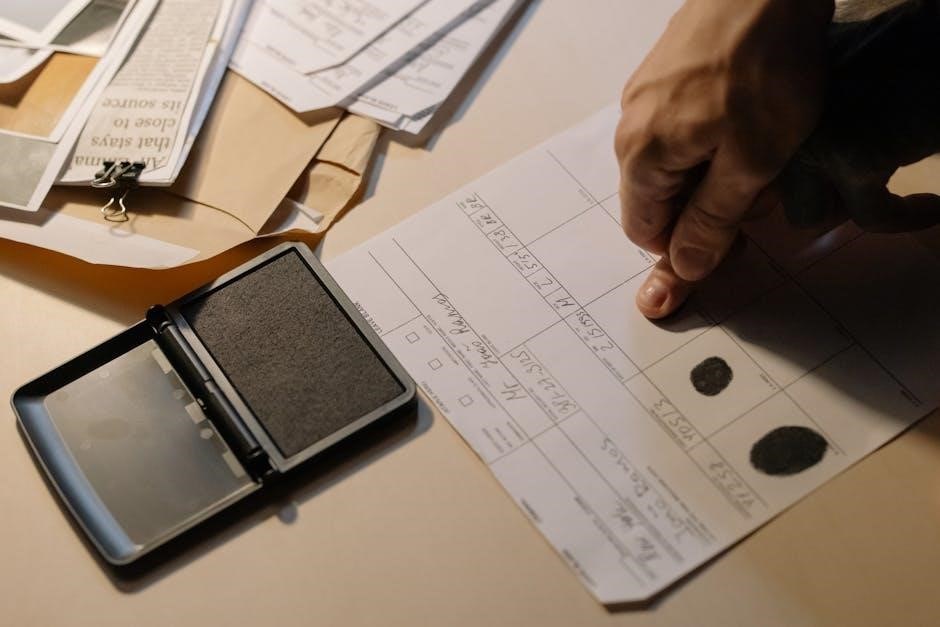Overview of the VFC400 Data Logger
The VFC400 data logger is a reliable device for monitoring vaccine temperatures‚ ensuring they are maintained safely. It stores temperature readings from an external probe. The display shows temperature excursions and current status. Alarms trigger if readings are outside preset limits‚ vital for vaccine management.
Key Features and Benefits
The VFC400 data logger offers several key features and benefits crucial for effective vaccine monitoring. It reliably measures and stores up to 15‚905 temperature readings‚ ensuring comprehensive data capture. A prominent display indicates temperature excursions‚ current readings‚ recording status‚ and battery life‚ providing at-a-glance insights.
Its alarm system alerts users to temperature breaches‚ enhancing responsiveness. The logger’s compatibility with both old and new docking stations simplifies data downloads via USB. The VFC400-WiFi model generates detailed PDF reports‚ which include data charts‚ lists‚ and day summaries. A CSV file is also available for further analysis.
The VFC400-SP’s hot-swappable smart probe enables recalibration without interrupting data logging. With its user-friendly design and compliance features‚ the VFC400 ensures vaccine integrity‚ minimizes downtime‚ and streamlines temperature monitoring processes. This makes it an indispensable tool for healthcare facilities managing vaccine storage. Its comprehensive features enhance efficiency and reliability.
VFC400 Data Logger Kit Components
The VFC400 data logger kit includes essential components for comprehensive temperature monitoring. At the core is the VFC400-SP data logger‚ designed for fridge and freezer temperature monitoring. It ensures the safe storage of vaccines and pharmaceuticals. The kit features a stainless steel temperature probe encased in glycol‚ providing accurate readings.
This probe‚ connected via a cable‚ transmits data to the logger. The kit also includes an acrylic stand for the probe and mounting equipment for the logger. Adhesive-backed zip tie mounts are provided for secure placement. To facilitate data retrieval‚ a docking station is required‚ although sold separately.
The VFC400-SP kit features a plug-and-play‚ hot-swappable smart probe for easy recalibration. This eliminates downtime. The kit delivers a complete solution for maintaining vaccine integrity. It offers reliable temperature monitoring. With all necessary hardware included‚ users can quickly set up and maintain optimal storage conditions‚ enhancing overall efficiency and compliance.

Initial Setup and Configuration
To begin‚ download and install the VFC 400 software (LogTag Analyzer). Connect the docking station to the computer’s USB port. Firmly insert the data logger into the docking station. Configure alarm settings within the software to match requirements;
Software Download and Installation
The first crucial step in utilizing your VFC400 data logger involves downloading and installing the necessary software. This software‚ often referred to as LogTag Analyzer‚ is essential for configuring the device‚ downloading recorded data‚ and generating reports. Begin by visiting the official website or the designated software download portal provided by the manufacturer‚ such as vfcdataloggers.com‚ to ensure you obtain the latest version of the software.
Locate the appropriate download link for the VFC400 model and initiate the download process. Once the download is complete‚ proceed with the installation. Double-click the downloaded file to launch the installation wizard. Follow the on-screen prompts carefully‚ accepting the terms and conditions‚ and selecting the desired installation directory.
Ensure that your computer meets the minimum system requirements specified by the software. After installation‚ verify that the software icon is present on your desktop or in the programs menu. Launch the software to confirm successful installation and prepare for the next steps in configuring your VFC400 data logger for optimal performance.
Configuring Alarm Settings
Configuring the alarm settings on your VFC400 data logger is crucial for ensuring timely alerts when temperature excursions occur‚ safeguarding the integrity of your vaccines or pharmaceuticals. Begin by opening the LogTag Analyzer software on your computer. Connect the data logger to your computer using the docking station‚ ensuring it is firmly inserted into the USB port.
Within the software‚ navigate to the “Configuration” or “Settings” menu. Here‚ you will find options to set the high and low temperature alarm limits according to your specific requirements. Refer to the guidelines or protocols established by your clinic or healthcare facility for the appropriate temperature ranges.
Additionally‚ you can configure alarm delays‚ specifying the number of consecutive samples that must exceed the set limits before an alarm is triggered. This feature helps prevent false alarms due to momentary temperature fluctuations. Once you have configured the desired alarm settings‚ save the changes and disconnect the data logger from the computer. The VFC400 is now ready to monitor temperatures and alert you to any deviations outside the specified range.
Operating the VFC400 Data Logger
Operating the VFC400 involves starting/stopping the logger and proper placement. To start‚ hold the start button until “STARTING” appears. Correct probe placement is essential for accurate temperature readings. Regular data downloads maintain effective vaccine storage monitoring with the VFC400 device.
Starting and Stopping the Logger
To initiate the VFC400 data logger‚ press and hold the START button until the word “STARTING” appears on the screen. Continue holding the button until the word “STARTING” stops flashing‚ which typically takes about 4 to 6 seconds. Once the flashing ceases‚ release the button. The display should then show the word “RECORDING‚” indicating that the data logger is actively monitoring and logging temperature data.
To stop the VFC400 data logger‚ press the START/CLEAR/STOP button. The display will then show “STOPPED‚” indicating that the logger is no longer recording data. It is recommended to stop the logger prior to downloading any recorded data to ensure data integrity. The display will also show the number of days for which data has been collected.
Remember to download data regularly to prevent data loss. If the logger displays an “X‚” it indicates an alarm condition‚ requiring immediate action. Properly starting and stopping the VFC400 data logger is crucial for accurate and continuous temperature monitoring‚ ensuring the safety and efficacy of vaccines. Always verify that the display reflects the desired operating mode.
Placement of the Data Logger and Probe
Proper placement of the VFC400 data logger and its probe is crucial for accurate temperature monitoring. The stainless-steel temperature probe‚ often encased in glycol‚ should be positioned within the vaccine storage unit to accurately reflect the internal temperature. Ensure the probe is placed near the vaccines‚ avoiding direct contact with the unit’s walls or cooling elements to prevent inaccurate readings. Use the provided acrylic stand or mounting equipment to secure the probe in an optimal location.
The data logger itself can be placed outside the storage unit for easy access to the display and buttons‚ or inside if necessary‚ ensuring it remains visible. Avoid placing the logger in direct sunlight or areas with extreme temperature fluctuations. Secure the logger with adhesive-backed zip tie mounts if needed.
When connecting the probe‚ ensure it is firmly plugged into the data logger. A proper connection is indicated when the probe is recognized by the logger and the temperature is displayed correctly. Consistent and strategic placement of both the logger and probe guarantees reliable temperature data‚ essential for maintaining vaccine integrity.

Downloading and Analyzing Data
To download data from the VFC400‚ use the docking station connected to a computer. The LogTag Analyzer software allows data retrieval and analysis. PDF reports can be generated‚ providing data summaries‚ charts‚ and statistics for review and compliance.
Docking Station Connection
To download data from the VFC400 data logger‚ begin by opening the LogTag Analyzer software on your computer. Next‚ connect the docking station to a USB port. Firmly insert the VFC400 data logger into the docking station. Ensure that the logger is properly seated to establish a reliable connection for data transfer. Both red and blue data loggers are compatible with both old and new docking stations.
Once connected‚ the software will recognize the data logger and initiate the downloading process. This process transfers the stored temperature readings from the logger to your computer for analysis and reporting. After the download is complete‚ you can view the logged data.
It is recommended to stop the logger prior to downloading the data. The display should indicate “STOPPED‚” showing the number of days collected. This ensures that all data is properly saved before transferring. Select “LogTag” from the drop-down menu in the LogTag Analyzer software to begin the download.
Generating PDF Reports
The VFC400-WiFi data logger can generate detailed PDF reports when connected to a computer via a USB port. This report provides a comprehensive summary of the data logger’s trip‚ presenting the information in both chart and list formats for easy interpretation. The PDF includes a day summary page‚ offering an overview of the statistics collected during each day of operation.
In addition to the PDF report‚ a CSV file containing the data is also available; This CSV file allows users to further analyze the data using spreadsheet software or other data analysis tools. The PDF report generation feature is particularly useful for quickly documenting temperature monitoring activities.
The report shows an overview of the data collected during the monitoring period. It includes key statistics such as minimum‚ maximum‚ and average temperatures‚ as well as any alarm events that occurred. This comprehensive reporting capability makes the VFC400-WiFi a valuable tool for maintaining accurate temperature records.

Troubleshooting and Support
When encountering issues with your VFC400 data logger‚ several resources are available to assist in troubleshooting and resolving problems. For immediate assistance‚ online tutorials offer guidance on common issues. Chat support provides real-time help from experts familiar with the VFC400.
If the data logger displays an ‘X’‚ indicating an alarm‚ immediate action is required. Begin by checking the temperature of the storage unit and ensuring it is within the acceptable range. Also‚ verify that the probe is correctly connected to the data logger and properly positioned within the unit.
For software-related issues‚ ensure you have the latest version of the LogTag Analyzer software installed. This software is essential for downloading and analyzing data from the VFC400. If problems persist‚ consult the user manual. The guide provides step-by-step instructions for resolving common issues.

Calibration and Maintenance
Maintaining the accuracy of the VFC400 data logger involves regular calibration. The VFC 400-SP model features a smart probe‚ allowing for recalibration without removing the data logger. This hot-swappable probe ensures minimal downtime during calibration.
Proper maintenance is essential for the longevity of the VFC400. Regularly inspect the device for any physical damage. Check the probe cable for wear and ensure it’s securely connected. Clean the data logger and probe with a soft‚ dry cloth to remove dust and debris.
Replace the battery as needed to ensure continuous operation. Refer to the user manual for instructions on battery replacement. When not in use‚ store the data logger in a cool‚ dry place away from extreme temperatures. Periodically verify the accuracy of the data logger against a certified thermometer. Proper calibration and maintenance are critical for reliable temperature monitoring.

